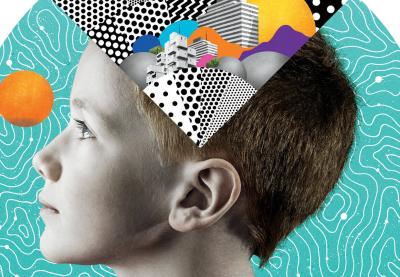Editor’s note: Teaching Tolerance generally uses people-first language. The individuals interviewed for this story, however, prefer the term autistic people rather than people with autism. Out of respect for their preference, we have adjusted our usage.
School was never easy and rarely pleasant for Elly Wong. Their* smarts were not a question. They had learned to read by age 3, and grade school teachers suggested they skip a grade. But social interactions were difficult and classroom settings often battered their senses. “I’m sensitive to noise and get easily overstimulated,” Wong says. “My strongest impressions of elementary school are constant crying in response to being overwhelmed.” As the meltdowns continued into high school, a counselor recommended a psychological evaluation.
By that time, Wong had been doing independent research “through the magic of the Internet” and piecing together clues for a self-diagnosis. The psychiatrist agreed: anxiety, depression and Autism Spectrum Disorder (ASD). Wong proceeded to negotiate their own 504 plan; their parents knew little about autism and “the professionals at my school were pretty unhelpful.” The accommodations were relatively minor: Extra time on tests, use of noise-canceling headphones and subtitled videos were among them. Even so, Wong says, “I got constantly challenged over my accommodations.”
Last fall, they enrolled as a first-year student at Syracuse University in New York.
Working with and educating students like Wong who are on the autism spectrum has been the subject of much discussion and controversy in the last generation. The narrative has often been that children with these diagnoses are sources of tragedy for families and a drain on schools. Educators unfamiliar with autism and its range of expressions have often been perplexed and intimidated by students in their classrooms. Even as autism awareness has grown, many districts still lack the resources to help their teachers and schools update their practices and become more inclusive of affected students and families. Often, special education teachers must rely on their own research and resourcefulness.
In recent years, however, the neurodiversity movement, characterized by the advocacy of autistic individuals speaking for themselves, has entered the conversation. Advocates and their allies are eager to challenge pessimistic attitudes toward ASD and share insights for helping their fellow autistic people learn, cope and thrive in settings—particularly educational settings—that have often been indifferent, if not unwelcoming, to their needs.
“No one knows more about autism, about what it’s like to be autistic or what autistic people need, than autistic people ourselves,” says Julia Bascom, deputy executive director of the Autistic Self Advocacy Network (ASAN). “We have a unique first-person perspective, and that perspective absolutely has to be centered in any sort of advocacy work focused on our community.”
Old-School Autism Education
Though our understanding has grown significantly in recent years, the first diagnosis of autism as a distinct neurological disorder only occurred in the 1940s. Decades later, British psychiatrist Lorna Wing successfully made the case that autistic behaviors take different forms in different people, from nonspeaking individuals capable of little social engagement to those adept at navigating—or excelling—in society. Building on 1930s research by Austrian Hans Asperger, Wing described an “autism spectrum” and championed its 1980 inclusion in the bible of psychiatry, the Diagnostic and Statistical Manual of Mental Disorders, or DSM.
Today, ASD is viewed as a neurological disorder in a person’s ability to send social cues or process incoming ones. “By definition, autistic people have a language impairment,” says Sharon Rosenbloom, a speech pathologist, founder of Turning Pointe Autism Foundation and mother of Joey, an adult autistic son. “They’re neurologically disorganized.” Along with those issues, many autistics deal with high levels of anxiety and hypersensitivity to sensory stimulation.
Traditional autism therapy has emphasized teaching autistic kids to act as “normal” as possible. “We often see schools focusing on social skills training and behavior modification to make children appear less visibly autistic,” says ASAN’s Bascom. Unfortunately, these therapies have frequently come at the expense of engagement and learning.
Applied Behavior Analysis (ABA therapy) has been the cornerstone of traditional therapy. ABA therapy recommends 40 hours a week of repetitive drills and positive-reinforcement techniques to attempt to replace unwanted behaviors with more socially acceptable ones. For example, the teacher or therapist may work with an autistic child one-on-one to gradually build up his or her ability to maintain eye contact, perhaps rewarded with something like a sip of juice. Reducing self-stimulation—the flapping of hands, rhythmic rocking, fidgeting with a favorite object or other repetitive motions associated with autism—is also stressed. ABA works on verbal skills as well, promoting speech fluency in speaking students and having nonspeaking students pick out flash cards to develop the association between words and objects.
Critics of ABA therapies express frustration with their concentration on students’ deficits at the expense of celebrating their interests or strengths. Ido Kedar, a nonspeaking autistic teen, expresses his contempt for ABA in his book, Ido in Autismland. His deficits are not cognitive, but a self-described neurological disconnect between mind and body. “In school I sat through ABC tapes over and over and added 1 + 2 = 3 over and over,” he recalls. “I was bored out of my wits. It made me die inside. I was like a zombie inside because I had no hope.”
“Too often we teach autistic students using a deficit model—spending our time trying to fix what they can’t do instead of building out from what they can,” says Leah Kelley, a veteran special education teacher near Vancouver, British Columbia, and mother of an autistic son. “It’s a pathologized and medicalized model.”
It is past time to update and upgrade those models, says Kelley and other autism advocates and allies. More and more, the theories of medical experts and proponents of “cope till you cure” are being overwritten by the lived experiences of autistic kids and adults themselves. They want to share their narratives, and—thanks to new thinking in communication therapies as well as new assistive technologies—more are having the chance to tell them. An emerging theme? Autistics want help but are wary of people trying to “fix” them.
Too often we teach autistic students using a deficit model—spending our time trying to fix what they can’t do instead of building out from what they can.
Multiple Methods
In his book, Kedar describes his early life as feeling trapped in an insubordinate body; not even those closest to him knew how to reach him. As a nonspeaking autistic, he had no words to call for help, and dyspraxia blocked him from being able to accurately signal his needs. His movements and actions often appeared impulsive and chaotic.
Kedar indicates the big breakthrough in his ability to express himself came at age 7. While trapped with his own thoughts, he had been learning to read. Now he also began to write, forming words with a letter board and—eventually—by typing. The process was painstaking, but it soon became clear that he was an aware and articulate kid with a strong desire to express himself. With the means to communicate, Ido progressed rapidly, and within two years was being mainstreamed in several of his middle school classes. Now in high school, he is reported to be on a college-bound track.
For many advocates and allies, matching autistic students with the means to communicate to the best of their ability is priority number one. But there is no one-size-fits-most fix, says Rosenbloom. She likens the process to being fitted for eyeglasses. “When I get the right prescription, I can see well,” she says. In the same way, any prescription to aid communication for those on the autism spectrum requires customization.
“Some of us will be able to speak fluently, but our speech may not match what we want to say, while others might not be able to use oral speech as well,” explains Bascom. “Autistic students should have multiple methods of communication made available to use, whether that looks like a dedicated speech-generating device, a text-to-speech app on an iPad, sign language, or a pencil and paper. But it’s not enough to just give someone access to an alternative; autistic students with communication impairments need qualified staff working with us who can systematically teach the hows and whys of communication as well.
Two recent books, NeuroTribes by Steve Silberman and In a Different Key by John Donvan and Caren Zucker, offer compelling narrative histories of the scientific and social explorations of autism’s complexities and perplexities.
Presume Intellect
Bascom and Rosenbloom agree on another point when it comes to working with autistic students: Presume intellect. That means not talking about autistic students in the third person when they are present. That means speaking to them in tones and complete sentences appropriate for their age, not baby talk. Rosenbloom says she has witnessed autistic kids respond to a new teacher speaking to them normally with a look that says, “Whoa!”
“I have a mantra: Develop a relationship,” she says. “Presume there’s a mind in there, ready to teach you something you don’t know.”
Relating and communicating are practices that too often have been absent from autism education. Many autistic people are very aware when non-autistic educators are underestimating or patronizing them. Rosenbloom contends that respectful and meaningful interaction has the potential to reduce aggressive and self-injurious behaviors as autistic students learn to trust they can get their needs met without melting down.
Honoring that trust is another part of helping autistic individuals connect with the world. After years of acquiescing to the wills of others, many have developed understandable stores of resentment toward ableist attitudes. They need to be able to say "no" to what is being asked and trust it will be respected, says Kelley, who argues that better treatment for autistic people is a matter of social justice. “We dehumanize people when we don’t let them say 'no.' So much of their therapy has been compliance based, which is a real denial of dissent. Unless you allow dissent, whatever 'yes' you get is absolutely meaningless.”
This position echoes the motto of ASAN: “Nothing About Us Without Us.” More and more autistic young people and adults—like Elly Wong, Julie Bascom and Ido Kedar—are ready and determined to inform improvements in educational policies and practices that affect them and other neurodiverse students. Their contributions to more inclusive schools can only benefit us all, wherever we live on the neurodiversity spectrum.
*Wong’s preferred pronoun is they.
Glossary of Autism-related Terms
Applied Behavioral Analysis (ABA)
Therapies targeted to increase or decrease specific behaviors
Asperger syndrome
A disorder on the autism spectrum, distinguished by relatively intact language and cognitive skills; as of 2013, Asperger syndrome was eliminated as a distinct diagnosis and folded into the autism spectrum
Assistive and adaptive technology
Devices or equipment used to facilitate functional capabilities of people with disabilities; for autistics, these may include computer tablets and software to aid communication
Dyspraxia
Difficulty with coordination and motor planning
High-functioning/low-functioning autism
Terms traditionally used to describe the severity of autism in individuals; autism advocates now reject this usage
Neurodiversity
The concept that neurological differences in people represent normal, natural variations; many autism advocates embrace this term as a way to challenge pathologized models of autism
Prompt
A cue or hint to assist communication or behavior by autistic students
“Stimming”
Self-stimulating behavior; repetitive movements or vocalizations common in autistic individuals as a means for calming or entertaining themselves
Tactile defensiveness
Extreme sensitivity to specific textural stimuli



